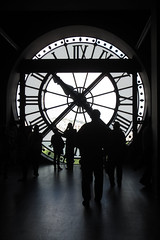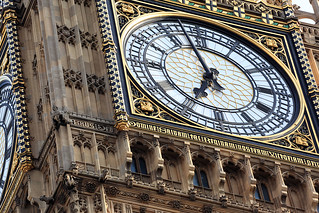

| Archive Blog Cast Forum RSS Books! Poll Results About Search Fan Art Podcast More Stuff Random |
|
Classic comic reruns every day
|
1 {photo of a large building clock from a strange angle}
1 Caption: Time is Relative
|
First (1) | Previous (3246) | Next (3248) || Latest Rerun (2891) |
Latest New (5380) First 5 | Previous 5 | Next 5 | Latest 5 Annotations theme: First | Previous | Next | Latest || First 5 | Previous 5 | Next 5 | Latest 5 This strip's permanent URL: https://www.irregularwebcomic.net/3247.html
Annotations off: turn on
Annotations on: turn off
|
The Michelson-Morley experiment disproved the idea that there was some sort of medium, the hypothesised luminiferous aether, through which light waves propagated. This posed some interesting new problems about the nature of light.
Firstly, it was clear that other sorts of waves were waves in something. Water waves were the back and forth sloshing motion of water. Sound waves were the back and forth sloshing of air molecules (or other molecules, if the sound was travelling through something else). Seismic waves were the back and forth sloshing of bits of the Earth. What was sloshing back and forth in the case of light waves? This was why the luminiferous aether was proposed in the first place - it was what sloshed back and forth to carry light waves. But by the early 1900s it was clear that no such aether existed.
So what does slosh back and forth in a light wave? The answer is electric and magnetic fields. Neither electric nor magnetic fields need a medium - they can both exist in a vacuum. It seems simple enough now, but this realisation took decades after Maxwell's formulation of the equations governing the relationship between light and electromagnetism.
The second problem about the non-existence of the aether is more subtle. It was known that the speed of light was close to 300,000 kilometres per second. We're going to be referring to this speed a lot today, so instead of typing it out in full each time, I'm going to use the symbol commonly used by physicists for the speed of light, which is the italicised letter c.

Train, moving at speed. |
But speed is always measured relative to something else. The speed of a train, for example, is usually measured relative to the ground beneath it. A train might be moving at 40 km/h compared to the ground beneath its tracks. But you could also, if you wanted, measure the speed of the train relative to... the sun, for example. In this case, its speed would be something like 30 km per second, since that's the speed that the Earth and everything on it moves around the sun. The 40 km/h speed of the train relative to the surface of the Earth, and the speed of Earth's rotation, would also come into it, but these are both quite a bit slower than 30 km/s. You could also measure the speed of the train relative to another train moving in the opposite direction on a parallel track. If this second train is moving at 50 km/h relative to the ground, then relative to this second train the first train is moving at 40+50, or 90 km/h. And if you're on a horse trying to catch up to the first train in order to catch the bad guy, and your horse is running at 41 km/h behind the train, then you're gaining on the train at a speed of 1 km/h, and that's your speed relative to the train.
If the aether existed, then light would presumably move through it at the speed c relative to the aether. If you were on a train moving at 40 km/h relative to the aether in the same direction as a beam of light, then you'd see the light moving relative to you at c minus 40 km/h, and if the train was moving in the opposite direction as a beam of light, then you'd see the light moving relative to you at c plus 40 km/h. Before Michelson and Morley did their experiment, this is exactly what we thought happened. The main problem was that 40 km/h is so slow compared to c that it was impossible to measure the difference in the relative speed of light with the instruments available at the time. So any experiments to confirm or refute this could not be performed. Michelson and Morley's experiment was clever enough to get around this limitation, and pretty much showed that the aether simply didn't exist.

You could totally play cricket on board this moving train. |
So if light isn't moving at c relative to some aether (because there is no aether), then it is moving at c relative... to what? The first thing that might occur to you is that the speed of light must be relative to whatever is emitting the light. This is the way other things work, after all. If you throw a ball at 100 km/h, then the ball is moving at 100 km/h relative to you. If you're standing on the ground then the ball moves at 100km/h relative to the ground, and if someone is standing with a bat waiting to hit the ball, the ball is moving relative to them at 100 km/h too. You can just as easily play a ball game on a moving train (well, if you bribe the conductor or something). If the train is moving at 40 km/h and you are throwing towards the front of the train, the ball moves at 100 km/h relative to the train, and the guy with the bat standing at the front of the train faces a situation similar to outside - he has a ball moving relative to him at 100 km/h to hit. But relative to the ground beneath the train, the ball is moving at 140 km/h. And if you stand at the front of the train and throw towards the back, the batter still faces a 100 km/h ball, but relative to the ground outside the ball is only moving at 60 km/h.
Now imagine instead of throwing a ball you shine a torch (or flashlight for the Americans) at your friend. No matter what end of the train you're at, it's reasonable to assume that the light leaves your torch at speed c relative to you, and arrives at speed c relative to your friend. But what about relative to the ground outside the train? If you shine your light toward the front of the train, that light should be moving at c plus 40 km/h relative to the ground outside, while if you shine it backwards it should be moving at c minus 40 km/h relative to the ground outside. And for a while after Michelson and Morley showed that the aether didn't exist, this was what we thought happened.
Enter: Albert Einstein. The now famous scientist was working as an examiner in the Swiss Patent Office in the early years of the 20th century. He was assigned to examine patents involving fundamental engineering and physics principles. So although his job is frequently described as being a "clerk", it was actually very technical, not simply administrative paper shuffling. He was thinking about cutting edge physics all day. It's not as if he was doing accounting spreadsheets and then suddenly decided to think about complicated physics and make huge fundamental advances. (Sorry to all you office workers out there.)
Anyway, an aspect of the whole speed of light thing bothered him. Einstein imagined what a light wave would look like if you could move faster and faster, catch up to it, and ride along next to it, at the same speed. James Clerk Maxwell had already demonstrated that light was an intertwined wave of electric field and magnetic field, the oscillations of each one giving rise to the other and propagating together at the speed that popped out of his equations of electromagnetism (the speed c). The trouble as Einstein saw it was that, while this was all well and good when the light wave was moving, it fell apart if you looked at the wave while moving along with it. If you're travelling at the same speed as the light wave—i.e. the speed of light relative to you is zero—then the electric and magnetic fields are no longer moving through space (relative to you). The fields are oscillating in strength; each one grows stronger and weaker in a linked cycle, but they are no longer moving. In some autobiographical notes he wrote many years later, Einstein remarked, "There seems to be no such thing, however, neither on the basis of experience nor according to Maxwell's equations."

The person shining this torch is walking towards me. But the light from that torch still hits me at c. |
So if you can move at the same speed as a passing beam of light, you will see something that physically cannot exist. But, Einstein reasoned, the laws of physics must be the same, no matter how fast you are moving. Just because you are moving at some speed, you should not see something that cannot happen if you are moving at a different speed.
Einstein puzzled over this for several years, because the solution is not at all obvious. It required a huge leap of insight, and abandonment of ideas that had been accepted without question ever since Isaac Newton. The real question was: What was the speed of light measured relative to? This magical speed c just popped out of Maxwell's equations as the speed that oscillating intertwined electric and magnetic fields must move at, but the equations gave no indication what this speed was relative to. People just assumed it must be relative to whatever emitted the light. The breakthrough Einstein made was that this speed c must be the speed of light relative to everything.
The difference in these possibilities becomes apparent when thinking about shining a torch towards the front of a moving train. To everyone on the train, the light leaves the torch at speed c and hits the far end of the train at speed c. Fine. But if the train is moving at 40 km/h, then the light leaves the torch at speed c plus 40 km/h and hits the far end of the train at speed c plus 40 km/h... Ah, but this is where Einstein said, "No! It doesn't! Even measuring the speed of the light beam while standing on the ground outside the moving train, the light still travels at exactly c, not c plus 40 km/h."[1]
At first glance this may well sound nonsensical. But, Einstein argued, it is in fact the only way to make sense of the speed of light at all. The whole question of "What is this speed c measured relative to?" only has a sensible, non-paradoxical answer if you accept that it is relative to everything, no matter how fast you are moving when you measure it.

|
Having made this conceptual leap, the next thing was to work out what were the consequences of the speed of light being absolutely fixed, relative to everything. To approach this, Einstein imagined another scenario. Imagine that you look at a window and you see your reflection in it (it's dark outside, say). The process of seeing your reflection begins with light leaving your face (it's ambient light reflected off your face, but that part isn't important). This light travels straight to the window glass (at speed c), and reflects straight back at you (at speed c), so you see it when it hits your eye. Let's say you are half a metre from the window, so the total round trip of the light beam is 1 metre. How long does the light beam take to leave your face, bounce off the window, and return to your eye? It's the distance (1 metre) divided by the speed of light c, which we can write as (1 m)/c. (See Figure 1.)
But wait! You're actually sitting on a train, and the train is moving! To you, this makes absolutely no difference - the train window isn't moving relative to you, after all. You and the window may as well be sitting still. The light still takes the time (1 m)/c to leave your face, reflect off the window, and bounce back to your eyeball. That's your point of view.
To make things interesting, let's imagine the train is moving a lot faster than a mere 40 km/h. Let's imagine it is moving at half the speed of light, or c/2.[2] If this is the case, then to someone standing outside the train, Figure 2 shows what the situation on the train looks like. While the beam of light is travelling from your face to the window, the train is actually moving forwards. By the time the light hits the window, the train will have moved forwards a bit. Which means the path of the light beam is not perpendicular to the window, it's a diagonal. The speed of the light beam along this diagonal is c (because, as Einstein pointed out, the speed of light has to be c, no matter where you are when you measure it), while the speed of the train along the tracks is c/2. So the triangle in the Figure has its sides in the proportion shown: 1 along the diagonal and 1/2 along the direction of motion of the train. Using nothing more complicated than Pythagoras' theorem, we can calculate that the distance the beam of light travels from your face to the window, according to the person standing outside the moving train, is 1/sqrt(3) metres, or about 0.577 metres. The light bounces off the window and returns to your eyeball, travelling another 1/sqrt(3) metres, for a total distance travelled (according to the person standing outside the moving train) of 2/sqrt(3), or about 1.155 metres.

An old railway clock. |
Okay so far, fine. But think about what this means. The light beam, according to you sitting on the train, travels a total distance of 1 metre from your face, to the window, and back to your eye, and the time it takes to do this is (1 m)/c. But according to the person outside the train, the light beam travels a total distance of about 1.155 metres, and because this person also sees the light beam is moving at speed c, the time it takes to do this is (1.155 m)/c. The time is different!
This was the mind-boggling breakthrough that Einstein realised must be happening when things move relative to one another. While the person outside the train sees a stopwatch tick off 1.155 seconds, a stopwatch carried by the person on the moving train only ticks off 1 second. In other words, time itself is passing more slowly for the person on the moving train - as measured by the person outside the train. That last part is important. You, sitting on the train, don't notice anything at all unusual about what's happening around you. The light travels 1 metre and takes time (1 m)/c to do so, no problem.
This time dilation[3] effect only becomes apparent when you look at a clock that is moving relative to you. Any clocks moving relative to you look like they are running more slowly. It's not some weird optical illusion either - time really is passing more slowly for those clocks. And here's where things get even weirder (or perhaps less weird, depending on your point of view). Because to you, sitting on the train, it looks like the person standing outside is moving. And if you do the calculations, you get exactly the same result, only applied to the person outside. To you, on the moving train, it looks like time is passing more slowly for the person outside. It's exactly symmetrical. In fact, that's the only way it can be, because there's no way to tell which person is "really" moving - motion can only be measured relative to something else.
Similarly, there's no way to tell which person's time measurement is the "real" amount of time passing. Each one is equally real. Everything is measured relative to the movements of other things - none of them is "really not moving". it's this central notion of relativity that gives its name to what this turned into: Einstein's theory of special relativity. (The "special" part indicates that it applies only in special circumstances, specifically when the effects of gravity are small enough that they are negligible compared to the motions of the objects involved. Einstein's more general theory that includes the effects of gravity is called, funnily enough, general relativity.)

Time warping! |
And here's where the famous twin paradox raises its head. The basic question is as follows: Imagine the person on the platform is your identical twin, born at exactly the same time[4]. If you on the train see time passing more slowly for your twin than you, while they see time passing more slowly for you than themself, which one of you is actually older after your train trip? You think your twin on the ground should be younger, while your twin thinks you should be younger. This is the so-called paradox.
The twin paradox is not actually a paradox, because there is an answer. While you are moving on the train, then to you, your twin is aging more slowly, while to your twin you are aging more slowly. But you can only compare ages properly when the train stops and you get off, so you're both standing together, without one of you moving. And to do that, you need to reverse direction and come back to your twin. The catch is in the reversing direction. This involves acceleration, or a change in speed. As this happens, as the train slows down, comes to a stop, and then speeds up back towards your twin, it looks to you like your twin is aging faster, rather than slower.[5] And in fact it's enough to outweigh the slower aging of your twin that occurs as you travel (either away from or back towards your twin). The result is that when you return from your very fast train trip away and back, you step off the train and both of you will find that you are now younger, and your stay-at-home twin is older.
The next question that arises is: Is all of this real? It's all well and good to say Einstein figured this out by deciding that the speed of light must be the same relative to everything, but ... really? It sounds wacky. How can time pass at different speeds for different people? Firstly, the effects of Einstein's relativity are only noticeable when things move at very fast speeds, approaching the speed of light. At the sort of speed we are used to, even flying in a jet, which is about as fast as most people ever travel, the effect of time dilation is so close to zero as to not be noticeable. Even at half the speed of light, as calculated above, the time dilation effect is barely a 15% difference. You could notice this with accurate clocks, but without them you might not notice it at all.
Secondly, some things do travel fast enough, and we do have clocks accurate enough to measure the resulting time dilation. Satellites and deep space probes have accurate timekeeping on board, and every measurement ever taken using them and compared to Einstein's theory of relativity show that Einstein got it right. If you ignore Einstein and just use Newton's laws of motion, you get the calculations of satellite orbits and planetary space probe trajectories wrong. You have to use Einstein to get them right. The GPS satellites you use to navigate in your car or on your phone only work because they accurately take into account relativistic time dilation. If they didn't, the entire GPS system would fail to work. So there's plenty of direct evidence that what Einstein figured out is correct. So next time your GPS navigator saves you from getting lost, spare a thought for Albert Einstein. Without his revolutionary thoughts on the speed of light just over a century ago, you would indeed have got lost.
[2] This clearly isn't <insert your local train network here>!
[3] The derivation of time dilation on the linked Wikipedia page is essentially the same as the one I've just gone through here, only with a bit more algebra and with a more general speed difference. If you're comfortable with high school algebra, you should be able to follow it.
[4] In reality identical twins are usually born a few minutes apart, but let's ignore that and imagine they can be born at exactly the same time.
[5] The details as to why are too much to go into today. This is already turning into a long annotation.
|
LEGO® is a registered trademark of the LEGO Group of companies,
which does not sponsor, authorise, or endorse this site. This material is presented in accordance with the LEGO® Fair Play Guidelines. |